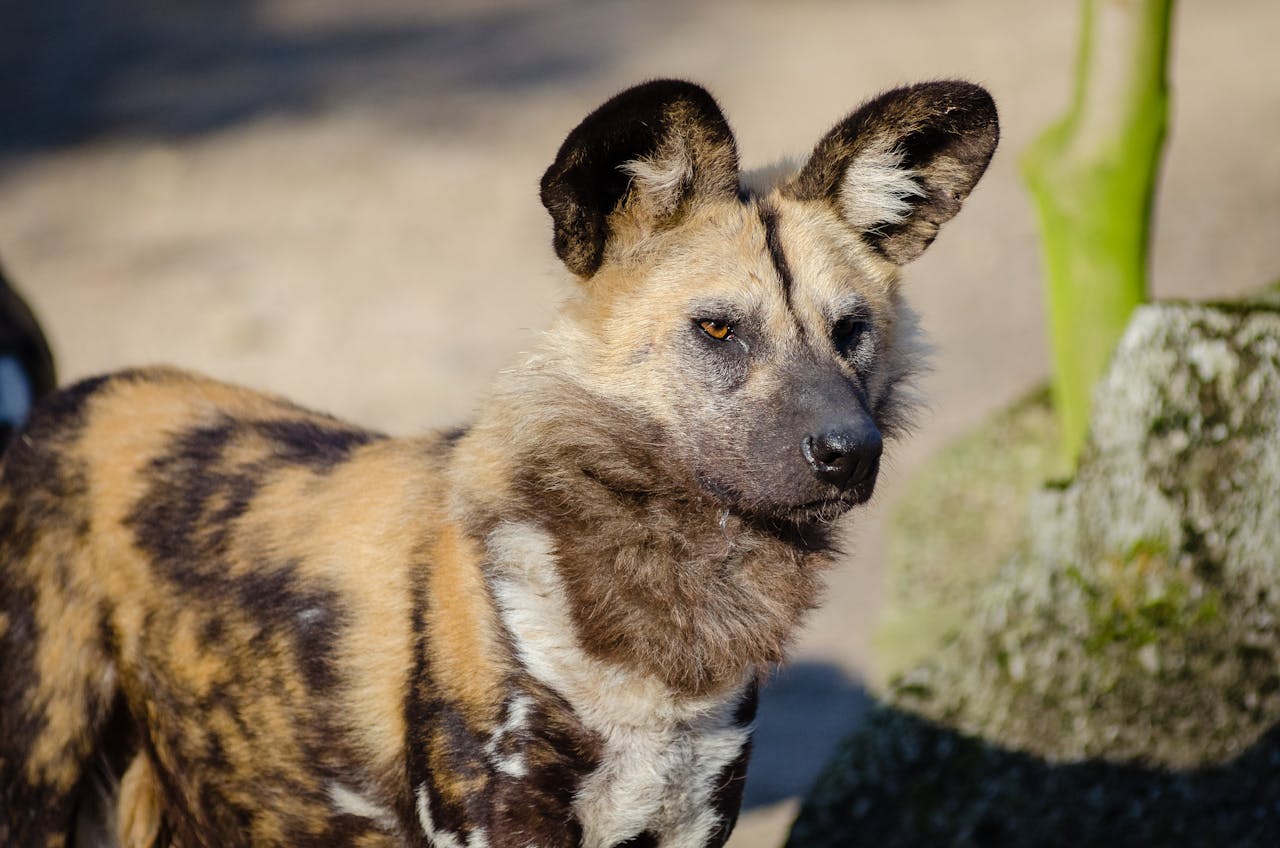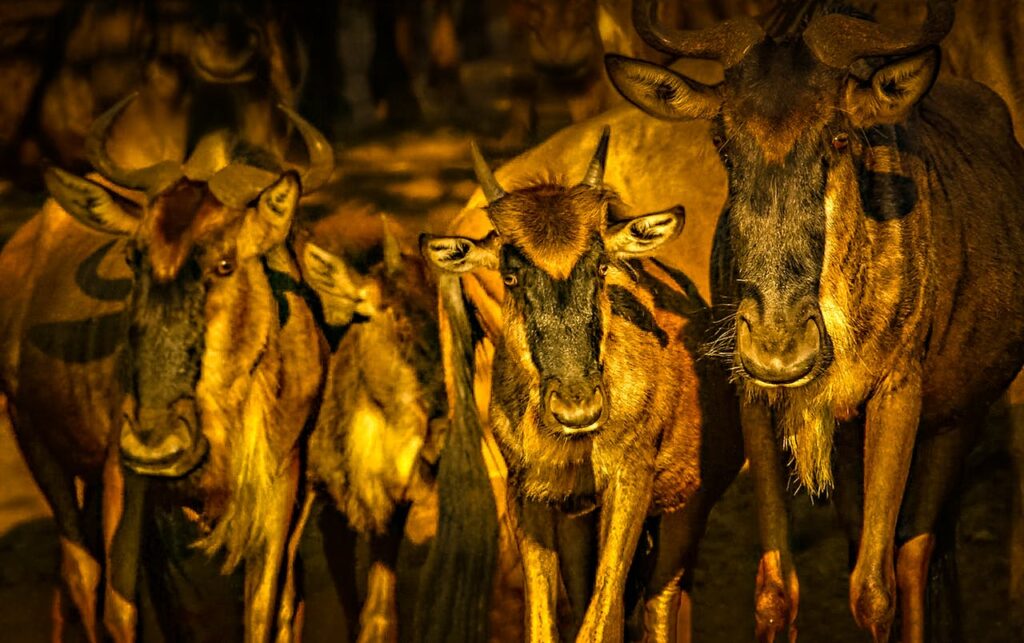The African wild dog (Lycaon pictus), often referred to as the painted wolf due to its striking, patchwork coat, is one of Africa’s most fascinating yet misunderstood predators. Once widespread across the continent, these highly social, intelligent canids are now endangered, surviving in fragmented pockets within protected areas like the Masai Mara. Known by many names—Cape hunting dog, painted hunting dog, ornate wolf, and even spotted dog—the wild dog’s role in Africa’s ecosystems is as vital as it is captivating.
Despite their ecological importance, African wild dogs face an uncertain future, threatened by habitat loss, human-wildlife conflict, and disease. This guide delves into the biology, behavior, and conservation of these remarkable creatures, highlighting their presence in the iconic Masai Mara.
1. Taxonomy: Neither Wolf Nor Dog
Though often mistaken for wolves or domestic dogs, the African wild dog belongs to a unique evolutionary branch as the only extant member of the genus Lycaon. Its scientific name, Lycaon pictus, translates to “painted wolf”, perfectly describing its mottled coat of black, yellow, brown, and white. Unlike true dogs, wild dogs lack dewclaws on their forelimbs and have specialized teeth adapted for a hyper-carnivorous diet.
- Ancestry: Wild dogs diverged from their common ancestor with wolves over two million years ago. While wolves evolved into domesticated dogs, the wild dog retained its unique characteristics, perfectly suited to life as Africa’s premier endurance hunter.
- Physical Traits:
- Large, rounded ears for excellent hearing and thermoregulation
- Slender, athletic build optimized for stamina
- Powerful jaws with scissor-like molars, ideal for quickly tearing flesh
2. Distribution: A Rare Jewel in the Masai Mara
Once ranging across sub-Saharan Africa, African wild dogs are now limited to isolated populations due to habitat fragmentation. In Kenya, small, endangered packs roam the Masai Mara ecosystem, although sightings are rare compared to more stable populations in Botswana’s Okavango Delta.
- Preferred Habitats:
Open grasslands, savannahs, and lightly wooded areas where visibility aids their pack hunting tactics. - Current Status in the Masai Mara:
Wild dog populations in the Mara fluctuate due to disease outbreaks (like rabies and canine distemper), human conflict, and competition with lions and hyenas.
3. Social Structure: The Democracy of the Pack
African wild dogs are among the most social of all canids, living in tight-knit packs dominated by a monogamous breeding pair. Unlike the rigid dominance hierarchies seen in wolves, wild dog leadership is based on cooperation and reproductive success rather than aggression.
- Pack Dynamics:
- Packs range from 6 to 20 individuals, sometimes larger.
- Alpha pair: Only the dominant male and female breed, while the rest assist in raising pups.
- Role Reversal: Unusually, females disperse from the natal pack to find mates, while males remain with their birth group.
- Communication:
Wild dogs are vocal animals, using high-pitched twittering sounds, chirps, and the unique “hoo” call to maintain pack cohesion. Pre-hunt rituals include enthusiastic jumping, bowing, tail wagging, and an intriguing sneezing behavior, believed to function as a form of democratic voting to determine if the pack should embark on a hunt.
4. Hunting: Masters of Endurance and Teamwork
Wild dogs are arguably Africa’s most effective hunters, boasting an 80% success rate—far higher than lions or leopards. Their hunting strategy relies on cooperative endurance running, where they chase prey over long distances until it collapses from exhaustion.
- Primary Prey:
Impala, Thomson’s gazelle, wildebeest calves, reedbuck, and even larger animals like zebras and warthogs when hunting as a large pack. - Hunting Tactics:
- Chase Strategy: Wild dogs can run at speeds of up to 60 km/h (37 mph) for sustained periods.
- Role Specialization: Some pack members flank the prey, others maintain pressure from behind, while the lead dogs anticipate the prey’s escape routes.
- Efficient Kill: They dispatch prey quickly, often through disembowelment, minimizing the suffering compared to other predators.
- Feeding Behavior:
Unlike many carnivores, wild dogs regurgitate food to feed pups, sick, or injured members—demonstrating a remarkable level of pack care and cooperation.
5. Reproduction and Lifespan: A Focus on Family
Wild dog reproduction is highly synchronized, with breeding occurring once a year during the dry season. The alpha female gives birth to the largest litters among canids, averaging 10–12 pups, in abandoned aardvark burrows for protection.
- Parental Care:
- Alloparenting: Non-breeding pack members actively participate in pup-rearing, including regurgitating food and guarding the den.
- Pup Development: Pups are weaned after 10 weeks and join the pack on hunts at around 3 months old.
- Lifespan:
Wild dogs live up to 10–12 years in the wild, though mortality rates are high due to predation, disease, and human-related threats.
6. Threats: A Battle for Survival
African wild dogs are classified as Endangered by the IUCN, with fewer than 6,000 individuals remaining globally. They have been on IUCN List since 1990 when chart below was published.

Their fragmented populations face multiple threats:
- Human-Wildlife Conflict:
Persecution due to livestock predation, accidental snaring, and retaliatory killings. - Habitat Loss:
Expansion of agricultural land and infrastructure limits their hunting ranges and dispersal corridors. - Disease:
Outbreaks of rabies and canine distemper, often transmitted from domestic dogs, can devastate entire packs. - Competition with Larger Predators:
Lions and hyenas frequently kill wild dogs, particularly vulnerable pups, and steal their kills.
7. Conservation Efforts in the Masai Mara
The survival of African wild dogs hinges on intensive conservation initiatives, many of which are active in the Masai Mara:
- Habitat Protection:
Preserving large, connected landscapes through the establishment of wildlife corridors and conservancies. - Disease Control:
Vaccination programs targeting domestic dogs around wildlife reserves to curb rabies and distemper outbreaks. - Research and Monitoring:
Ongoing studies using GPS collars to track movements, monitor pack health, and understand their ecological needs. - Community Engagement:
Working with local Maasai communities to mitigate conflict, promote coexistence, and create economic incentives through eco-tourism.
8. Wild Dogs as Ecosystem Indicators
Wild dogs are keystone species—their presence indicates a healthy, functioning ecosystem. As apex predators, they help control herbivore populations, prevent overgrazing, and maintain biodiversity through a process known as trophic cascades.
- Ecosystem Roles:
- Disease Control: By targeting weak or sick prey, they reduce the spread of wildlife diseases.
- Biodiversity Support: Their predation helps regulate herbivore populations, which in turn maintains diverse plant communities.
9. Fascinating Facts About African Wild Dogs
- Unique Coat Patterns: No two wild dogs have the same markings, making them easily identifiable to researchers.
- Social Butterflies: They are known for their affectionate behavior, constantly grooming, nuzzling, and playing with one another.
- Supreme Stamina: Their large lung capacity and long limbs make them one of Africa’s best endurance hunters.
- Silent Killers: Unlike lions, wild dogs hunt in near silence, relying on strategic coordination rather than brute force.
- Democratic Decisions: Their sneezing behavior during pre-hunt gatherings may act as a voting mechanism to decide when to hunt.
10. Where to See Wild Dogs in the Masai Mara
While sightings are rare due to their elusive nature, wild dogs can occasionally be spotted in less-touristy regions of the Masai Mara, particularly in private conservancies such as:
- Olare Motorogi Conservancy
- Naboisho Conservancy
- Mara North Conservancy
These areas provide better protection from human interference and fewer competing predators, increasing the chances of a wild dog encounter.
Final Thoughts: The Importance of Coexistence
The African wild dog embodies the spirit of the wilderness—free, resilient, and essential to Africa’s ecological fabric. Despite their endangered status, wild dogs continue to inspire awe with their complex social lives, hunting prowess, and boundless energy. In the Masai Mara, protecting these remarkable animals means safeguarding the integrity of one of the world’s greatest natural ecosystems.
By supporting responsible tourism, conservation programs, and local communities, we can ensure that the painted wolves of Africa remain part of the continent’s wild legacy for generations to come.
Additional Reading Resources;


